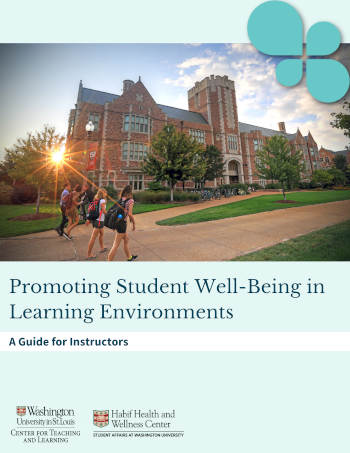Promoting Student Well-Being in Learning Environments
Resource Overview
Resources for course design, syllabus language, and class activities that support well-being
As part of WashU’s commitment to student well being, the Center for Teaching & Learning and Habif Health & Wellness have developed a guidebook for instructors called Promoting Student Well-Being in Learning Environments. The guidebook is based on the idea that we can help students meet our high standards and engage in the complex learning and exploration that we expect of them by creating learning environments that promote well-being. Even small shifts can make a major difference for students. Think of the guidebook as you would a menu. It provides a variety of evidence-based strategies and resources to choose from depending on the needs of your course. There are ideas you can use in course design, in developing your syllabus, in the first weeks of class, and throughout the semester.

About the Guidebook
The strategies and resources in the guidebook are centered around four keys to well-being:
 |
|
Supporting Students in Distress: In addition to providing strategies for supporting student well-being in your classes, this guidebook also offers suggestions for handling situations where you think a student may be experiencing psychological distress. As instructors, we can fulfill our role in the University’s network of support by recognizing warning signs, listening to students, and making referrals to mental health services when needed.
| To cite this guide: Center for Teaching and Learning. (2022). Promoting student well-being in learning environments: A guide for instructors. Washington University in St. Louis. https://ctl.wustl.edu/well-being/ |
Background
In the U.S. in 2019, 40% of students at colleges and universities reported having a significant mental health problem (Eisenberg et al., 2019). Additionally, from 2012 to 2019, the percent of students with positive mental health and well-being dropped from 57% to 40%.
These figures, alarming in and of themselves, should be particularly troubling for us as educators because of the role of well-being in student learning. Students with poorer mental health and well-being, whether they have a diagnosed mental illness or not, are more likely to experience academic difficulties (Eisenberg et al., 2009; Keyes et al., 2012; Mojtabai et al., 2015). A survey of Washington University students in 2020 confirms this connection: students reported that stress, anxiety, depression, and sleep difficulties were among the top factors negatively impacting their academics with 38% saying that stress significantly affected their performance (ACHA-NCHA III). In short, prioritizing student learning also requires prioritizing student well-being. Well-being includes “the presence of positive emotions and moods (e.g., contentment, happiness), the absence of negative emotions (e.g., depression, anxiety), satisfaction with life, fulfillment and positive functioning” (CDC, 2018). Critically, engaging students in practices that promote mental health and well-being must go beyond any single campus unit; it is the responsibility of our entire community to contribute to cultural change (Okanagan Charter, 2015).
Continued Efforts
To bring WashU faculty more information about how instructors and researchers in our community are supporting student well-being, the CTL will be interviewing faculty in order to share their strategies and research findings on our website. You can find our most recent interviews on our News page.
We will also have a series of events for WashU faculty throughout the Spring 2022 semester centered around these topics, check our Events page for upcoming workshops and virtual conversations.
If you would like to request a hard copy of the guidebook, please email Kat Weir, CTL Program Coordinator, at weir@wustl.edu.
Acknowledgments
This guide was adapted with permission from “Counseling and Mental Health Center. (2019). Texas well-being: Promoting well-being in learning environments guidebook. The University of Texas at Austin.”
The guide was created through collaborative effort between the Washington University Center for Teaching & Learning and the Habif Health & Wellness Center with contributions from Arie Baker, Eric Fournier, Meg Gregory, Denise Leonard, Savanah Low, Rick Moore, Shaina Rowell, Melissa Ruwitch, and Sally Wu.